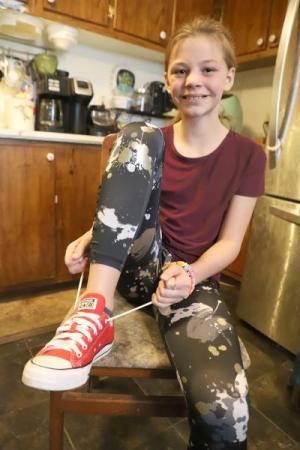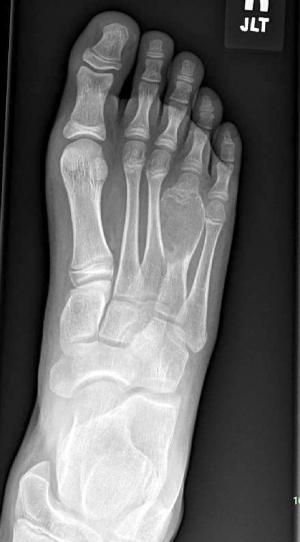
People exaggerate at times. Kids included. The mother of 12-year-old Isabella Shotts says her daughter can be a bit of a hypochondriac occasionally.
“I know that sounds rude,” said Tamara Shotts of Clark County, MO. “But she can over-react.”
After hearing their daughter complain of pain in her foot, Tamara and husband Jeff had reactions of their own when they saw the X-ray of Isabella’s right foot.
“I was worried and scared, all at once,” Tamara said.
“I knew it was something bad, but what it was I didn’t know,” added Jeff. “We had a lot of cancer in my family. That’s what worried me.”
The X-ray showed that 75 percent of the fourth metatarsal bone in Isabella’s right foot (the long bone that connects the toe to the foot), was affected by a bone tumor. It looked like a small water balloon that was putting pressure on the toes on either side of it.
And it hurt.
“I used to do cartwheels but I couldn’t do them anymore because I had a big pain in my foot.” Isabella said.
Tamara thought Isabella’s pain might have been the result of a sprain or strain. But during a visit for care not related to her foot pain, an X-ray showed the tumor. The Shotts family was referred to Mark Wavrunek, DPM, Blessing foot ankle surgeon. He identified the tumor as an aneurysmal bone cyst

“I’ve seen an aneurysmal bone cyst before,” said Dr. Wavrunek. “I’ve never seen one that size in a metatarsal before. It was the biggest I have ever seen.”
The good news for Isabella, her mom and dad is that aneurysmal bone cysts are non-cancerous. They are blood-filled lesions in the bone, surrounded by a thin wall of bone.
“It’s a type of tissue that starts to grow abnormally in the bone and takes the place of the bone,” Dr. Wavrunek explained. “It is a soft-tissue type of mass that tends to expand or grow.”
There is no clear cause of aneurysmal bone cysts.
Because of the size of the cyst and Isabella’s description of her pain, Dr. Wavrunek recommended surgery. Certified by the American Board of Foot and Ankle Surgeons and fellowship trained in foot and ankle reconstructive surgery, Dr. Wavrunek has experience in the management of large bone tumors and significant deformities of the foot and ankle.
He knew using Isabella’s own bone to repair the affected area would heal better than using a bone graft from an organ and tissue donor.
“I took a bone graft from her fibula (the shorter of two bones in the lower leg, sometimes called the “calf bone”) to fill in the area where the cyst was removed,” Dr. Wavurnek explained. “Then, I was able to use a bone graft from an organ and tissue donor to fill in the area on the fibula, because that bone bears less weight than the foot and has increased blood flow to aid in healing.”
Bottom line, Isabella was going to be doing cartwheels again.
“Around two months after surgery she was back in tennis shoes,” Dr. Wavrunek said. “At 12 weeks after surgery she was back in gym class at school. It was the best outcome we could have expected.”
Each member of the Shotts family appreciated Dr. Wavrunek’s care.
“I liked him,” Isabella said. “He told me every little thing that was going to happen. He tells you the truth.”
For more information on the care provided by Dr. Wavrunek and the Blessing department of podiatric medicine, click here.
